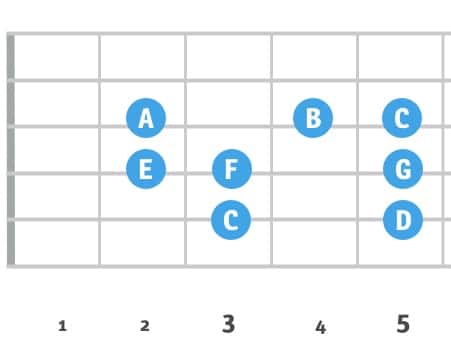
MUSIC THEORY
THE MAJOR SCALE
The major scale is a fundamental building block in western music theory. Read on to learn more
See the previous articles on Music Theory – strongly recommended to read these first!
The Major Scale
The major scale is the most popular scale in western music.
It is recommended to learn the major scale first – as it feels natural to the ear and is the core of much other music theory.
Learning this scale will enable you to understand:
- Intervals
- Chord construction
- Harmonization
- And much more
The Structure of the Major Scale
The major scale is contains 7 notes with the following intervals between notes
- Tone
- Tone
- Semi-tone
- Tone
- Tone
- Tone
- Semi-tone
You should practice this sentence: “Tone Tone Semitone – Tone Tone Tone Semitone”
We know from an earlier article that two notes are
- a tone apart if they are 2 frets apart on our guitar
- a semi-tone apart if 1 fret apart
Constructing the C Major Scale
Below is a diagram of the C major scale all played on one string (the A string starting at the 3rd fret)

Let’s examine this note by note
The first note is C.
Move up a tone (2 frets) to get the second note – D
Move up a tone from D to get the third note – E
Move up a semi-tone to get the fourth note – F
And then we move up 2 frets (tone) from F to G
Move up 2 frets (tone) from G to A
Move up 2 frets (tone) from A to B
And 1 fret (semi-tone) from B to C
(We note that the C major scale has no sharp notes but all 7 regular notes – CDEFGAB)
You can visualize the note intervals like this:

TIP:
It is important at this stage that you understand why for example C and D are a tone apart and why E and F are a semi-tone apart.
Re-read the intro to music theory if the diagram above is causing any confusion.
C Major Scale on Several Strings
Guitarists do not typically play a scale on one string.
Below is a way of playing C Major that involves several strings (but note that our left hand can stay between 2nd and 5th frets). Play it to check it sounds the same.

D Major Scale
We now construct the D major scale.
Start with a D note and calculate T-T-ST-T-T-T-ST
The D will move up 2 frets (tone) to E
The E will move up 2 frets (tone) to F#
The F# will move up 1 fret (semi-tone) to G
And so on.
The full scale is D, E, F#, G, A, B, C#, D

What’s interesting is that we can take the “shape” we had for our C major scale and “move everything up 2 frets” to get a D major scale.
Thus, learning a scale shape means that we can use it in any key if we begin with the right note.

We can generate major scale in any key in this way.
For example, we could move our C Major scale up 4 frets to get an E major scale.
Summary
- The major scale has 7 notes
- The C Major Scale contains no sharp notes – it is C D E F G A B
- Major scales have the following intervals between notes
- Tone-Tone-Semitone Tone-Tone-Tone-Semitone
More music theory articles
Get the Learn Fingerpicking Book
Register for the newsletter and I will send you this book (105 pages) and a free lesson once a month.
This is the ideal resource for complete beginners who wish to learn guitar.
